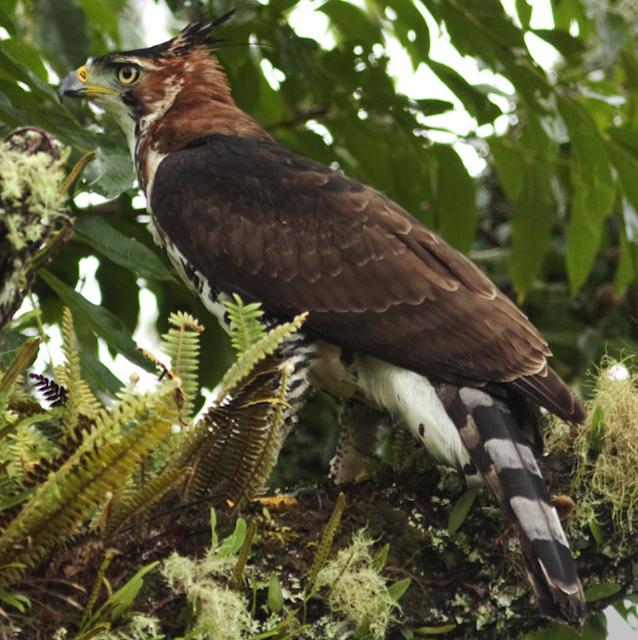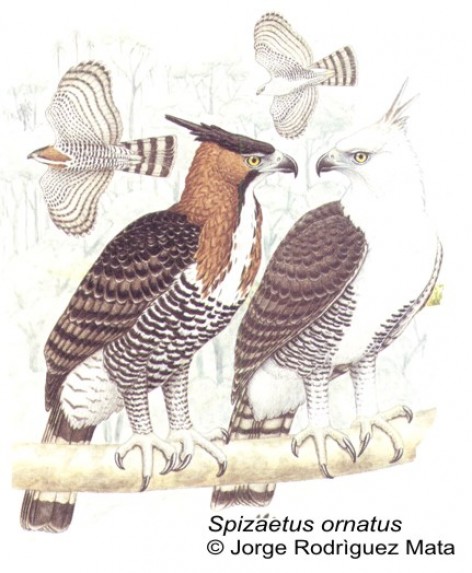Post by OldGreenVulture on Sept 22, 2019 13:00:18 GMT
Ornate Hawk-eagle - Spizaetus ornatus.

Scientific classification
Kingdom: Animalia
Phylum: Chordata
Class: Aves
Order: Accipitriformes
Family: Accipitridae
Genus: Spizaetus
Species: Spizaetus ornatus
Description: This is a medium-large raptor, at about 56.0–68.5 cm (22.0–27.0 in) in length, 117–142 cm (46–56 in) across the wings, and weighing about 960–1,650 g (2.12–3.64 lb). It has a prominent pointed crest, raised when excited, a black bill, broad wings, and a long, rounded tail.
The typical adult has blackish upper parts and crown, bright chestnut sides to the neck and breast, and a black-edged white throat and central breast. The rest of the under parts and feathered legs are white barred with black, and the tail has broad black bars. The under wings are white, with barred flight feathers; due to the heavy pattern, birds usually look rather dark in flight.
Sexes are similar, but young birds have a white head and under parts, with a grey crest, brown upper parts, and barring only on the flanks and legs.

Habitat: This bird is found in humid tropical forest from southern Mexico and the Yucatan peninsula, to Trinidad and Tobago, south to Peru and Argentina. They are able to tolerate some degree of habitat fragmentarion, breeding successfully near cities and in forest fragments as small as 200 ha (490 acres).
Diet: Despite a slender build and a body weight no greater than a large Buteo hawk, the ornate hawk-eagle is a notably powerful predator which, like other booted eagles, can take prey up to five times its own weight. Birds are the principal prey. Prey items have ranged in size from 180 g (6.3 oz) to 8 kg (18 lb) when taken. Prey species have included little blue herons, curassows, toucans, wood quail, pigeo macaws, parrot,cotingas, chickens, and even a black vulture. Mammals are also significant prey, with agoutis, squirrels, rats, procyonids, and monkeys often taken. Reptiles are also occasionally hunted.
Reproduction: The male's courtship display is a dive with folded wings, and a climb, sometimes completing a loop. The pair touch talons in flight as the female rolls on her back. This species builds a large stick nest in a high tree (e.g. Ceiba), many meters above ground. The nest is around 1 m (3.3 ft) in diameter. Most breeding activity occurs around April or May, differing slightly according to location; in Guatemala, breeding activity was observed from March to June, in Costa Rica in April and May, in Panama from November/December to May, and in the lowlands of Ecuador in March and April.
Status: Though locally rare, it was not considered a threatened species by the IUCN due to its wide range. In 2012, the species was uplisted to Near Threatened.

Credited to shenzi from Carnivora.
carnivora.net/ornate-hawk-eagle-spizaetus-ornatus-t3779.html#p19712

Scientific classification
Kingdom: Animalia
Phylum: Chordata
Class: Aves
Order: Accipitriformes
Family: Accipitridae
Genus: Spizaetus
Species: Spizaetus ornatus
Description: This is a medium-large raptor, at about 56.0–68.5 cm (22.0–27.0 in) in length, 117–142 cm (46–56 in) across the wings, and weighing about 960–1,650 g (2.12–3.64 lb). It has a prominent pointed crest, raised when excited, a black bill, broad wings, and a long, rounded tail.
The typical adult has blackish upper parts and crown, bright chestnut sides to the neck and breast, and a black-edged white throat and central breast. The rest of the under parts and feathered legs are white barred with black, and the tail has broad black bars. The under wings are white, with barred flight feathers; due to the heavy pattern, birds usually look rather dark in flight.
Sexes are similar, but young birds have a white head and under parts, with a grey crest, brown upper parts, and barring only on the flanks and legs.

Habitat: This bird is found in humid tropical forest from southern Mexico and the Yucatan peninsula, to Trinidad and Tobago, south to Peru and Argentina. They are able to tolerate some degree of habitat fragmentarion, breeding successfully near cities and in forest fragments as small as 200 ha (490 acres).
Diet: Despite a slender build and a body weight no greater than a large Buteo hawk, the ornate hawk-eagle is a notably powerful predator which, like other booted eagles, can take prey up to five times its own weight. Birds are the principal prey. Prey items have ranged in size from 180 g (6.3 oz) to 8 kg (18 lb) when taken. Prey species have included little blue herons, curassows, toucans, wood quail, pigeo macaws, parrot,cotingas, chickens, and even a black vulture. Mammals are also significant prey, with agoutis, squirrels, rats, procyonids, and monkeys often taken. Reptiles are also occasionally hunted.
Reproduction: The male's courtship display is a dive with folded wings, and a climb, sometimes completing a loop. The pair touch talons in flight as the female rolls on her back. This species builds a large stick nest in a high tree (e.g. Ceiba), many meters above ground. The nest is around 1 m (3.3 ft) in diameter. Most breeding activity occurs around April or May, differing slightly according to location; in Guatemala, breeding activity was observed from March to June, in Costa Rica in April and May, in Panama from November/December to May, and in the lowlands of Ecuador in March and April.
Status: Though locally rare, it was not considered a threatened species by the IUCN due to its wide range. In 2012, the species was uplisted to Near Threatened.

Credited to shenzi from Carnivora.
carnivora.net/ornate-hawk-eagle-spizaetus-ornatus-t3779.html#p19712

